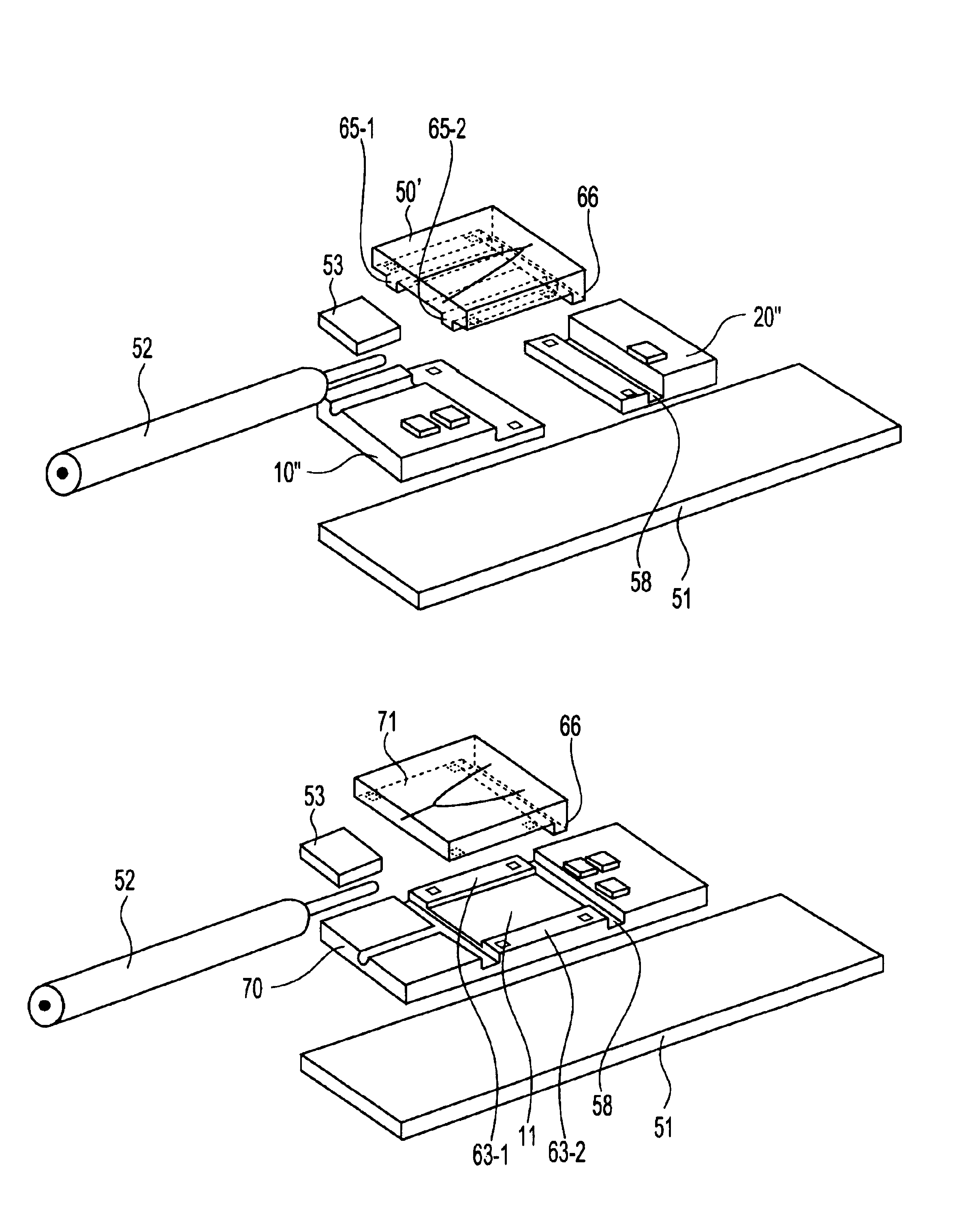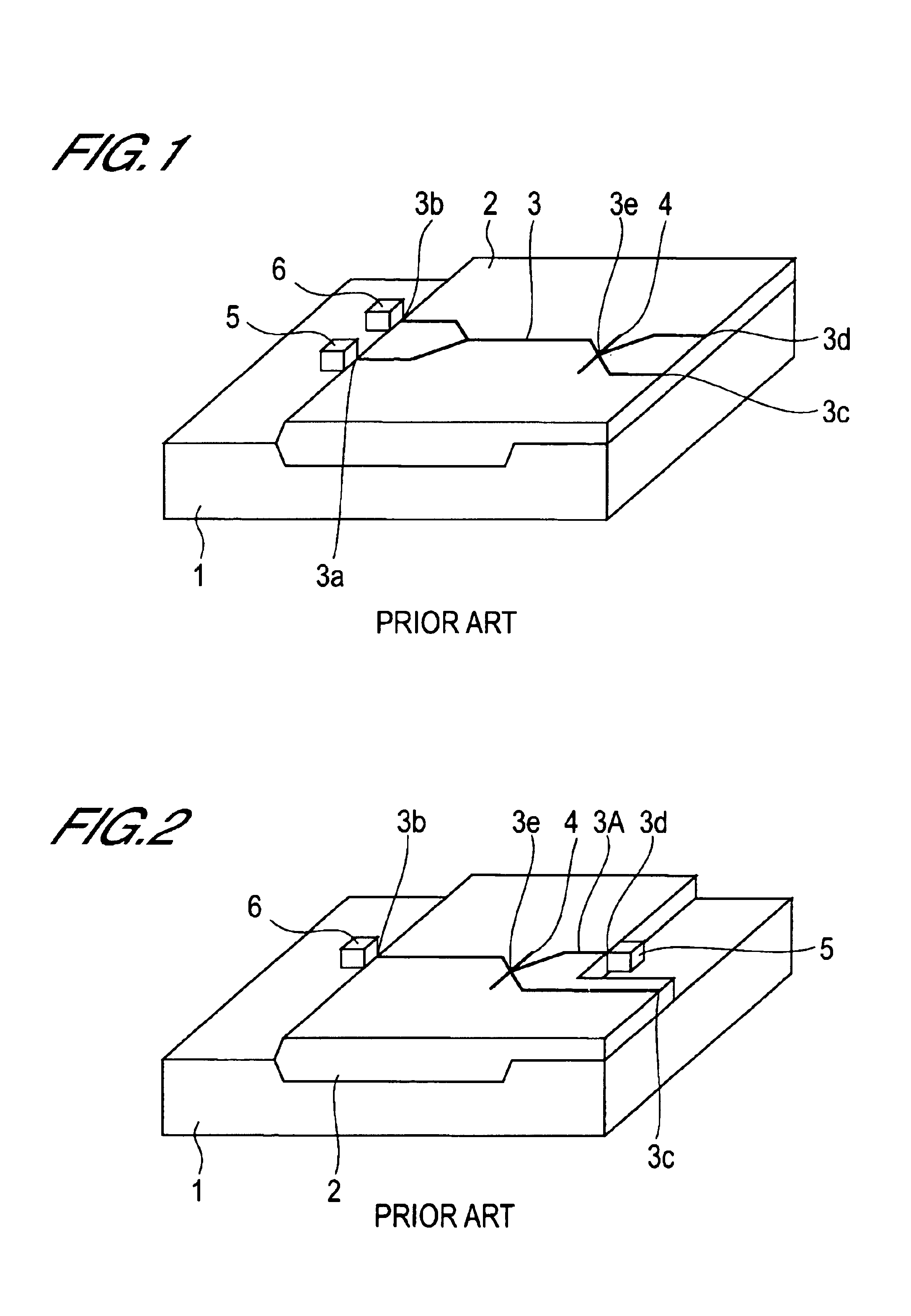Optical waveguide transmitter-receiver module
a technology of optical waveguide and transmitter, which is applied in the direction of optical waveguide light guide, instruments, optics, etc., can solve the problems of complex manufacturing process, limited quantity of manufactured units per unit wafer, and complex manufacturing process, so as to reduce the dimensions of the substrate on which light emitting elements and photo-receiving elements are mounted, increase the number of units manufactured from a wafer or similar, and reduce the adhesive area between substrates
- Summary
- Abstract
- Description
- Claims
- Application Information
AI Technical Summary
Benefits of technology
Problems solved by technology
Method used
Image
Examples
first embodiment
[0051
[0052]FIG. 4 is a perspective, exploded view of the optical waveguide transmitter-receiver module of a first embodiment of this invention, applicable to a π-PON system.
[0053]In this optical waveguide transmitter-receiver module, a strip or rectangle solid-shaped first substrate (for example, a silicon substrate) 10, on which are mounted optical elements, a strip or rectangle solid-shaped second substrate (for example, a silicon substrate) 20 having the same thickness as the silicon substrate 10, and for connection of optical fibers; and a strip or rectangle solid-shaped third substrate (for example, a PLC substrate) 30, on which is formed an optical waveguide, are separated. These three substrates 10, 20, and 30 are hybrid-integrated in a planar-mounted structure.
[0054]One of the principal surfaces of the silicon substrate 10, which is the upper face (hereafter simply “surface”), is flat, and in this surface, the first groove is formed (for example, an etched groove 11 is forme...
second embodiment
[0063
[0064]FIG. 5 is a perspective, exploded view of the optical waveguide transmitter-receiver module of a second embodiment of this invention as an example of application to an STM-PON system. Components which are common with components in FIG. 4, showing the first embodiment, are assigned common symbols.
[0065]In the optical waveguide transmitter-receiver module of the second embodiment, in addition to the V groove 22, another V groove 23 is simultaneously formed by etching in the silicon substrate 20 of FIG. 4. In this configuration example, the V grooves 22 and 23 are formed in parallel; but this does not limit the scope of this invention. The optical waveguide 31A formed in the PLC substrate 30 has entry / exit end faces 31a to 31d; a groove is cut, for example by dicing, in the branching part 31e joining the end faces, and a wavelength-selecting filter 32 is embedded. Otherwise the configuration is similar to that of FIG. 4.
[0066]In the method of manufacture of this optical wave...
third embodiment
[0070
[0071]FIG. 6 is a perspective, exploded view of the optical waveguide transmitter-receiver module of a third embodiment of this invention, as an example of application to an ATM-PON system. Components which are common with components in FIG. 4 and FIG. 5, showing the first and second embodiments, are assigned common symbols.
[0072]For example, in the optical waveguide transmitter-receiver module used in an ATM-PON system, the light emitting element 18 and photo-receiving element 19 operate simultaneously, and electrical crosstalk occurs via the silicon substrate between these elements, exerting adverse effects. Hence of the two separate first and second silicon substrates 10, 20, the photo-receiving element 19 is fixed in place by soldering or other means to the surface of the silicon substrate 10, and the light emitting element 18 is fixed in place by soldering or other means to the surface of the other silicon substrate 20.
[0073]Simultaneously with formation of the V groove 22...
PUM
 Login to View More
Login to View More Abstract
Description
Claims
Application Information
 Login to View More
Login to View More - R&D
- Intellectual Property
- Life Sciences
- Materials
- Tech Scout
- Unparalleled Data Quality
- Higher Quality Content
- 60% Fewer Hallucinations
Browse by: Latest US Patents, China's latest patents, Technical Efficacy Thesaurus, Application Domain, Technology Topic, Popular Technical Reports.
© 2025 PatSnap. All rights reserved.Legal|Privacy policy|Modern Slavery Act Transparency Statement|Sitemap|About US| Contact US: help@patsnap.com



